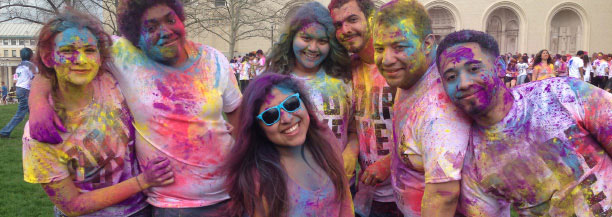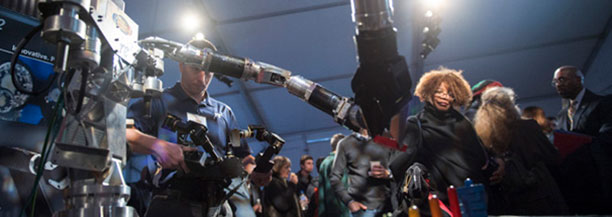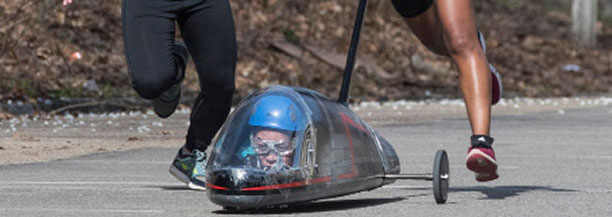Photo & Video Guidelines
Photography allows us to showcase Carnegie Mellon University's groundbreaking research, world-changing students and faculty, and high-profile events and initiatives. Showing these experiences is a crucial part of the CMU brand. While individual students, alumni, faculty and staff are incredibly important to our storytelling, it's important to show their interaction with others to reinforce the sense of collaboration and community. Throughout, we have the opportunity to capture stories that convey passion, ambition and a deep, practical engagement with challenges facing society. These are the pictures we strive to take and share with the world.
Video provides us an opportunity for storytelling — from multiple perspectives — in an efficient, engaging and emotive way. We can produce compelling videos of people, ideas, events and places across the Carnegie Mellon University community. Our videos should create a visual narrative and help advance the reputation of the university.
Photo & video principles
Show Experiences
Show students, alumni, faculty and staff in their environments and in interaction with others.
CMU Branding
If possible, include a brand or campus references in the frame.
Be Authentic
Be sure the image accurately tells the CMU story.
Consider the Pillars
You've heard it said that a photo is worth a thousand words, so let your images tell the story. Consider the message that you want the viewer to receive when viewing the image and then carefully consider the details and impact. Focus on capturing the Brand Pillars.

Diversity
Cultivating diverse perspectives and promoting inclusion are top priorities for the university and our photography should reflect the wide range of backgrounds, ethnicities and cultures represented in our community.

Innovation
A research university like no other, CMU is home to experts who lead their fields and create new ones. Our photography can visually document their groundbreaking research.

Quirkiness
Celebrate the uniqueness of our university culture with photography that makes you exclaim, "That is SO CMU."
CMU Stock Photography
CMU is a unique and authentic environment. Our photos should be just as unique and authentic. Always use CMU images, never generic stock photos. You can find a gallery of CMU photography in our CMU Selects Portal.
Video Best Practices
Production Suggestions
We encourage the engagement of professional videographers to help capture the CMU experience. However, we know that our community members are sometimes placed in the role of director, producer or even videographer. The following are recommendations that help us tell the best stories we can, regardless of who films them.
Develop a Plan of Action
We recommend engaging a professional video team whenever possible. Discuss an appropriate plan of action with the team before any shoot occurs. Establish appropriate roles and timelines, and communicate expectations of the team.
Respect the Relationship
All crew members, whether CMU staff or otherwise, must put the subjects first during any production. This means that we help create a comfortable environment, address any concerns in a friendly manner and always ask permission for engaging in any sensitive or personal matters.
Invite Narrative over Commentary
When conducting an interview, ask questions that welcome descriptive narrative responses. This requires asking questions that invite answers that paint a picture for an audience. For example, the question "Do you like your job?" does not invite the kind of response that potentially a question such as "What do you like about your job?" would invoke. Commentary driven questions often result in flat, short responses.
Capture Crisp & Well-Lit Video
It is important that our videos reflect the CMU brand by maintaining high-quality standards of production. Ensure the subjects are in focus, utilizing a shallow depth of field when appropriate. Compensate for poorly lit environments with professional lighting as needed.
Capture Appropriate B-Roll
When supporting a narrative-driven video, capture plenty of good b-roll (extra footage to help enhance the story). Capture b-roll that supports the narrative of the video. If possible, b-roll should feature people other than the main subject(s) of the video and show interactions between them.
Capture High-Quality Audio
Audio is as important as the visual capture in any video production. Avoid filming in locations with sporadic background noises and use equipment that records high-quality audio.
Provide Captions
Captions are text versions of the audio content, synchronized with the video. They are essential for ensuring your video is accessible to people who are deaf or hard of hearing. There are different options for including captioning in your videos; please contact the Office of Disability Resources at access@andrew.cmu.edu for more information.
The Basics
- Highlight the human relevance to the story.
- Spark inspiration and convey innovation.
- Capture emotion.
- Take into consideration the environment (i.e., uncluttered).
- Capture the subject in crisp focus (utilizing a shallow depth of field when appropriate).
- Be properly lit and well framed.
- Be concise and engaging throughout — avoiding long, uncut commentary.
- Utilize music in a way that establishes the appropriate mood and offers balance.
- Avoid copyright infringement by obtaining a license or other grant of permission from the rights holder before utilizing music in a video.
- Follow brand standards when utilizing any graphics or animation.
- Be captured by a professional or experienced videographer.
- Be accompanied by the requisite releases.
Shooting With a Mobile Device
Capturing with a Mobile Device
The following are best practices for when a professional photographer/videographer are not available and/or additional phone imagery is captured.
Stabilize the Shot
Due to the light weight of a phone, it is easy to shoot video or photos with significant shake. We recommend stabilizing the phone by supporting it with a solid surface or tripod or by using two hands.
Use Available Light
Utilize available daylight whenever possible and supplement with additional lighting sources as needed. Position subjects so that they are facing the light source (e.g., a window). Please note that shooting video on a phone typically requires more light than a still image, in particular when shooting inside or at dusk.
Pay Close Attention to Audio
Audio quality is often the biggest issue when filming with a mobile device, as most in-phone microphones are not sensitive enough to isolate an interview subject's voice from background noise. Film in as quiet of an environment as possible, and use plug-in external microphones if available.
Avoid Zooming In
Zooming in on a video will compromise the quality of the image and/or produce a grainy picture. We recommend leaving the phone in its native state while shooting. Move closer to your subject if needed.
Consider Composition
Subjects talking on-camera should be tightly framed, but not centered in the frame. If they are being interviewed, they should face the interviewer, slightly off-center. The background behind the subject should be interesting, but not distracting.
Shoot Horizontal
It is important to capture video footage in the horizontal format (16:9) as this will be the format in which the videos will be experienced. Photos can be captured in vertical format when the subject or scene calls for it, but this will most likely be in a limited state.